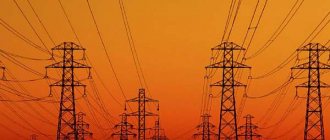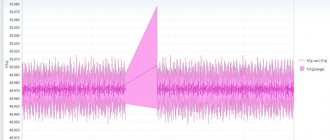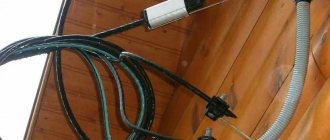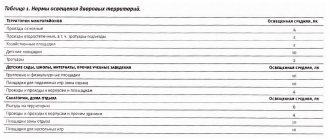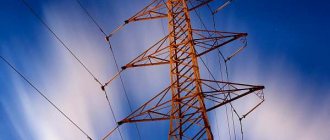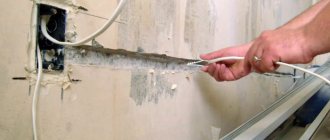It is known that dangerous electromagnetic waves emanate from high-voltage lines (OHVs). The approved provisions of SNiP regulate the minimum safe interval from power lines (power lines) to residential buildings, which depends on the voltage in the network. Based on these intervals, the sanitary zones of power lines under the overhead lines and the “encumbrance zone” are determined, which is an area at a dangerous distance from waves harmful to human health. The construction of any housing on the territory of the sanitary zone is strictly prohibited.
Minimum allowable interval
Charged particles, while moving through wires, form an electromagnetic field, that is, radiation, which is divided into constant and alternating. Frequent changes in electric current from plus to minus and in the reverse order produce a change in the field value several times faster.
As is known, electromagnetic radiation has a detrimental effect on the human body. The World Health Organization, based on the results of numerous scientific experiments, has approved permissible radiation standards. In many states, including our country, regulations have been created and legislatively approved that impose a ban on any construction in areas close to power lines.
People who were exposed to a powerful electromagnetic field for a long time subsequently suffered from serious illnesses, chronic fatigue, and their life expectancy decreased.
Scientific Evidence for the Benefits of Grounding the Body
If you are interested in a more in-depth scientific study, Dr. Briffa provides a more detailed explanation:
During normal metabolic processes, the body produces so-called "reactive oxygen species", which are commonly called "free radicals". These compounds appear to be important, at least in part, because they are able to attack and destroy unwanted things in the body, including bacteria and viruses. However, too many free radicals are bad, and they are implicated in chronic diseases. as well as in the aging process itself. Free radicals are involved in a process known as inflammation, which is part of the healing process.
However, low-grade inflammation throughout the body can lead to pain and other problems in muscles and joints, and is also considered a key driver of many chronic diseases, including heart disease and type 2 diabetes. In short, we want free radicals, but not too many. Free radicals lack sparks of energy known as "electrons." One way to suppress them is to give them electrons, and they can be supplied with nutrients such as vitamins A, C and E, as well as plant substances known as "polyphenols" (found in tea, coffee, cocoa, among others and apples). ). However, the substances we eat and drink are not the only way electrons enter the body: grounding does that too.
If there is a positive charge on the body, grounding allows electrons to flow into the body where, in theory, they can neutralize overexposed free radicals and inflammatory damage. Carrying a positive charge can affect the body in different ways, meaning that being grounded can provide a range of health benefits.
Tags: sconce, view, house, , grounding, ground, cable, like, , magnet, installation, voltage, potential, rule, wire, project, , work, repair, row, garden, ten, type, current, transformer, , shield, electricity, effect
Plots in the sanitary zone
Based on the provisions of SanPiN, a construction procedure and security zones under power lines were created. Children's institutions located at a dangerous distance from power lines must be closed immediately. In addition, it is strictly prohibited to construct residential buildings for various purposes closer to the safe interval range relative to power lines prescribed in SanPiN 2971-84.
The degree of danger of radiation can be clearly seen in the price indicators for land plots located in close proximity to power lines. Here the price of land is very low, and the price increases every 30 meters. But you should not be tempted by the low price, since first of all you need to take into account the importance of preserving the health of your family.
Safety rules in security zones of power lines are regulated by the Rules for the establishment of security zones of electric grid facilities and special conditions for the use of land plots located within the boundaries of such zones (approved by Decree of the Government of the Russian Federation of February 24, 2009 N 160)
Power lines are prohibited in security zones
|
|
|
|
|
|
Placement of objects in security zones of power lines
| Placing landfills is prohibited |
Warehouse and store materials, including fuel and lubricants:
|
Place children's and sports grounds, stadiums, markets, retail outlets, field camps, livestock pens, garages and parking lots (except for parking garages for individuals), hold public events:
|
Work in security zones, the implementation of which must be approved by JSC "ORES"
| construction, major repairs, reconstruction or demolition of buildings and structures |
| mining, blasting, reclamation work, including those associated with temporary flooding of land |
| planting and cutting down trees and shrubs |
| watering agricultural crops if the height of the water jet can be over 3 m. in security zones of overhead lines |
| placement of children's and sports grounds, stadiums, markets, retail outlets, field camps, cattle pens, garages and parking lots (except for parking garages for individuals), holding public events - in security zones of overhead lines up to 1 kV. |
| warehousing and storage of materials, including fuel and lubricants in security zones of overhead lines up to 1 kV. |
|
In the security zones of KL:
|
| catching fish, aquatic animals and plants using bottom fishing gear, setting up watering places, splitting and storing ice in protected areas of underwater cable lines |
| passage of vessels whose vertical distance from the upper outer gauge with or without cargo to the lower point of sag of the wires of overhead power line crossings through bodies of water is less than the minimum permissible distance, including taking into account the maximum level of water rise during floods - in the security zones of overhead lines, crossing bodies of water |
The application must be submitted no later than 2 weeks before the start of work.
Rules for navigation in power transmission line protection zones
In the security zones of underwater cable power lines:
| It is prohibited to drop anchors from vessels and to carry out their passage with released anchors, chains, lots, drags and trawls. Land on the shore in places fenced with signal signs indicating the place where submarine cables are brought ashore. Carry out loading and unloading and dredging work, carry out hydrological, blasting and survey work. |
| Approval from JSC "ORES" is required for: catching fish, aquatic animals and plants using bottom fishing gear, setting up watering places, splitting and harvesting ice. |
In security zones of overhead power lines:
| It is prohibited to pass vessels with raised booms of cranes and other mechanisms. Written permission from ORES JSC is required to install moorings for ships, barges and floating cranes. |
| It is necessary to obtain approval from JSC "ORES" for the passage of vessels whose vertical distance from the upper outer gauge with or without cargo to the lower point of sag of the wires of overhead power line crossings through water bodies is less than the minimum permissible distance, including taking into account the maximum level of water rise at flood |
In the event of a cable being lifted by an anchor or fishing gear, ship captains (ship commanders) are obliged to take all measures to free the cable without causing damage to it, regardless of the loss of the anchor or gear.
Power transmission line security zones and their sizes.
Security zones are established for all electrical grid facilities.
1. Security zones along overhead power lines (hereinafter referred to as OHL).
- The upper limit is the height of the overhead line supports.
- Lateral boundaries are measured from the outermost wires. Depends on the overhead line voltage and wire type. Self-supporting insulated wire (SIP) has a higher safety class due to its insulating polyethylene coating.
| Voltage, kV | Distance, m | |
| up to 1 | 2 | |
| 1 — 20 | 10 (5 - for SIP) | |
| 35 | 15 | |
| 110 | 20 | |
| 150- 220 | 25 | |
| 300-750 | 30 | |
| 750-1150 | 40 | |
| 1150 | 55 |
2. Security zones along underground cable power lines.
- The lower limit is equal to the depth of laying cable power lines.
- Lateral borders - on both sides of the outer cables at a distance of 1 m.
- The security zone of cable lines with voltages up to 1 kV under city sidewalks towards buildings is 0.6 m.
3. Security zones of underwater cable power lines
- The lower boundary is the bottom.
- Lateral boundaries - on both sides of the line from the outermost cables at a distance of 100 m.
4. Security zones when crossing overhead power lines through bodies of water
- The upper limit is the height of the overhead line supports.
- Lateral borders - on both sides of the outer wires at a distance of:
- for navigable reservoirs - 100 m. - for non-navigable reservoirs - at the distance provided for the establishment of security zones along overhead power lines (see clause 1).
Information signs
Information signs must indicate the width of the security zones of cable lines and the telephone numbers of cable line owners.
Signs are installed in a plane perpendicular to the axis of the power line.
- For overhead power lines: on support posts every 250 m.
- For underground cable lines - on separate racks every 100-500 m, as well as in places where the direction of cable lines changes, on both sides of intersections with roads and underground structures.
- For submarine cable lines - placement of signs on the shores in accordance with the current rules of navigation along inland shipping routes and sea straits.
Safe distance to power lines
The standardized width of the sanitary zone does not meet the standards for maintaining a safe distance for the construction of residential buildings. Its value is 2 times less and its measurement is carried out not from the outermost wires of the power line, but is indicated by one value with the center of the overhead line axis.
Sanitary zones of overhead lines:
Permissible distances from buildings to power lines and their dependence on the voltage indicator:
- 20 kV – from 10 meters;
- 35 kV – from 15 meters;
- 110 kV – from 20 meters;
- 150 – 220 kV – from 25 meters;
- 300 – 750 kV – from 30 meters;
- 750 – 1150 kV – from 40 meters.
At what distance should you not live near power lines: safe distance to live
At what distance should you not live near power lines:
- To avoid risks, the routes of electromagnetic fields that pass through such lines are delineated by sanitary protection zones. Their size corresponds to the voltage class and ranges from 20 to 55 meters (in Moscow these values range from 10 to 40 meters ).
- The distance is calculated from the wall of the house to the wires. Within these zones, the construction of housing, summer cottages, public buildings, as well as the location of gardens and vegetable gardens is not allowed.
- These values do not take into account the magnetic field surrounding the power line. Therefore, experts recommend that to fully guarantee safety, consider the distance to be ten times the specified standards.
- For example, the distance around low voltage lines within a radius of 100 meters is a completely sufficient sanitary protection zone. The fact is that there are no official data regarding harmful emissions from power lines, so you should focus on the standards established by documents and your own well-being.
Opinions vary about how dangerous it is to live near power lines . Those who consider them dangerous cite statistics of deaths in areas where high-power power lines pass to prove that they are right. Doctors do not completely agree with this statement and refer to their own indicators and calculations.
Opinions about the harm vary
The truth, as usual, is in the middle: constantly being near the support of a 750-kilovolt line, it is quite possible to feel unwell. If the contact with the power line is not constant and the correct distance from it is maintained, the body is unlikely to react to the influence of the electromagnetic field.
Possible harm to human health
A voltage of 10 kV is officially recognized as safe for people, creating a background whose density is no more than 10 µT. For example, the Earth's magnetic field emits 30 μT, which every person experiences constantly.
Prohibitions in the power line zone:
Electric current flows through the overhead line with a frequency of 50 Hz, that is, the current changes direction 50 times per second. The magnetic field changes in the same order.
It is worth noting that if people are often exposed to a magnetic field with high levels, malfunctions may occur in the body. This also applies to household appliances that a person uses constantly, for example, a hair dryer, refrigerator, computer.
Standards for distances from supports:
Permissible intervals from power lines and the harm caused to human health are absolutely interconnected. In the European Union, housing construction is permitted within an interval of at least 20 meters from the sanitary protection zone.
European standards for housing construction:
| Voltage, kV | Security zone, m | Norm, m |
| 35 | 15 | 35 |
| 110 | 20 | 40 |
It is worth noting that the site area for any construction is to some extent located closer to the power lines than the minimum distance from the residential building. This area is designated in the technical documentation as the encumbrance zone. In this territory it is not prohibited to erect a fence and plant a vegetable garden, but to build residential premises is not allowed.
Is it dangerous to live near power lines?
- in the electromagnetic field of power lines for a long time, depending on the state of human health, can have an adverse effect on the cardiovascular system, reproductive and immune, endocrine and nervous systems ; it is possible that the level of leukocytes in the blood may exceed the normal level, it is possible and the risk of cancer.
Despite everything, power lines are quite important
- A person may feel a constant loss of strength, become overly irritable, and the immune system is weakened. There is a version about the ionization of dust particles and impurities near them by power lines, which has a harmful effect on the functioning of the respiratory system.
- Is it dangerous to live near power lines? Pregnant women, children and people with weakened immune systems should stay away from them It has been noted that this category of people may experience headaches and increased blood pressure.
There are countries in which a person exposed to the harmful effects of power lines can, at public expense, change their place of residence to a more comfortable one in this regard.
- It should be noted that electromagnetic fields surround a person not only near power lines . They are emitted by any household and office equipment, mobile phones, which are much closer to human brain cells.
- How strongly such a field influences a person or an ecological system depends on the power and duration of stay in it. In addition, industrial current has a frequency of 50 Hz, and humans perceive much lower frequencies.
- In order to reduce the adverse effects of power lines , shielding devices and means that reduce field strength in the area where power lines are located can be used.
- If the power line is located close enough to the residence, good protection is corrugated sheeting or metal tiles used in the manufacture of roofs; reinforced concrete walls, which weaken the effect of radio waves due to the reinforcing mesh, are considered the safest in this regard. In this case, both the grid and the roof must be grounded.
- By the way, it is important to know that fishing near power lines is strictly prohibited. And if near your dacha there is a lake with fish, and nearby there are dangerous power lines, then refuse to relax with a fishing rod.
You can't fish
- If a person lives near power lines or is often close to operating electrical equipment and feels ailments that he associates precisely with the influence of electromagnetic fields, it is useful for him to often travel to environmentally friendly areas located outside the range of power lines: to the mountains, to the sea coast, to forests. arrays.
There are special accredited laboratories that can carry out the appropriate measurements. Their findings and conclusions have the force of a legal document. The maximum permissible field strength is 0.5 kV/m indoors and 1 kV/m for the building area.
Determination of power line voltage indicator
In the process of planning the acquisition of a plot of land, you should make sure that the overhead lines are located at a safe distance from the proposed construction site. Such data is not always available, but you can find it out yourself by the number of wires and insulator disks near the pole.
Standards for placing overhead lines in various areas:
Determining the value of consumer voltage by the number of wires in the cable:
| Number of wires, pcs. | Voltage, kV |
| 1 | 330 |
| 2 | 330 |
| 3 | 500 |
| 4 | 750 |
| 6 – 8 | from 1 000 |
In this case, it is necessary to count not the number of cables, but the number of wires in a bundle of one of them. In addition, the height of the poles along which the wires are stretched will help you get your bearings: the higher the poles, the higher the voltage in the wires.
When there is one wire in the line, it is possible to find out the voltage indicator by the number of insulators, that is, ceramic disks on one branch. The standards here are:
- from 3 to 5 insulators – 35 kV;
- from 6 to 8 – 110 kV;
- from 15 – 220 kV.
When tension is dangerous
Voltage in power lines can be dangerous or harmless. There is a connection between the range of the electric field generated by a power line and the power of this line.
Power line support
These quantities are directly proportional. To calculate the voltage, you need to take into account that the total number of wires in the connecting phase of one phase varies. The voltage is:
- 2 wires – 330 kV;
- 3 wires – 500 kV;
- the presence of 4 wires indicates a voltage of 750 kV.
In order to protect people from negative side effects, PUE (Electrical Installation Rules) standards were prescribed for the distance from home to power lines, which should be followed during the construction of a residential building and the construction of non-residential public buildings. When purchasing a plot near a power line, the permitted distance must be observed.
Typical voltage value in residential areas
Within the areas of residential areas, power lines have a voltage of 6 to 10 kV, and there is no generation of radiation that exceeds the permissible values for people.
Power line supports and voltage indicators:
According to the provisions of SNiP, buildings for various purposes must be located 5 meters from the “red line”. Only a wire that is connected directly to the building can violate the safe distance.
The insulator securing the wire outside the building must be located on the wall of the building at a height of at least 2.75 meters. The entry of wires into the house should not be located above the entrance or near the rooms where people are most often. A safe place could be, for example, the wall of a utility room, pantry or hallway.
The sag of self-supporting insulated wires over a pedestrian path or walkway must be at least 3.5 meters, the sag between the supports of high-voltage lines - from 6 meters above the ground.
Pulling wires to connect a building from the opposite side should only be done using additional supports. In this case, the height to the insulators must be at least 6.2 meters, and the minimum horizontal interval from the overhead line with a voltage rating of 6 kV to high vegetation is 2 meters.
Methods of protection against magnetic fields
As you move away from power lines, the emitted magnetic field gradually decreases, but does not disappear completely. The normative provisions of SanPiN specify the distance when this value reaches the permitted value. According to experts, an absolutely harmless distance is approximately 10 times higher than the permissible values. Placement of poles near the home:
Dwellings built at a distance closer than 100 meters from lines with a household voltage indicator and 200 meters from overhead lines must be equipped with protection from the electromagnetic field.
High voltage power line near the house
What should be the safe distance from power lines to residential buildings? To give a comprehensive answer to this question, we will analyze the reasons for the danger that power lines pose.
Electricity has become an integral part of our lives, and we can no longer imagine our existence without household electrical appliances, cell phones and familiar gadgets, and yet all of them are fraught with hidden danger.
Why is current dangerous?
The main danger, it turns out, is electromagnetic radiation, which comes from all electrical appliances and spreads over a long distance around. Only as you move away from the source does its indicator slowly fade. It differs in frequency ranges and is characterized by wavelength: radio waves, infrared and ultraviolet radiation, visible and x-ray radiation and, finally, gamma radiation. Their daily influence on humans is not safe.
Using scientific research methods, scientists were able to determine the effect of these fields on the concentration of ions in the cells of the body. A pathological change in this value is fraught with metabolic disorders. Refrigerator, TV, electric hood, built-in electric hob, air conditioner, washing machine, microwave oven - this is an incomplete list of secret spiteful critics. And yet, electromagnetic radiation from household electrical appliances is not so great, since it is determined by the power of the radiation source and the duration of exposure.

